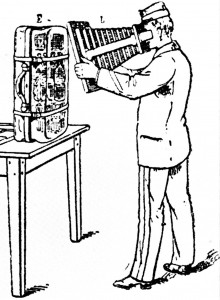A week or so ago, shoes off and stuck in the slow moving security check line at an airport, I became fixated as I watched the luggage screeners at work. I wished I could see what they were seeing on their screens, and wondered what they were trained to look for, and how long anyone of us might stay alert and focused on the life-and-death details embedded in images they were paid to scour. While some people argue, as Richard Resak did in The New Brain: How the Modern Age is Rewiring Your Mind, that the temptations and stress of modern life are shortening our attention spans, there are still instances when we’re called upon to look at images more carefully than usual.
But, it turns out, that is difficult to do for long stretches of time. Our eyes continually dart around within the borders of the images we look at. Visual concentration is taxing and hard to maintain, which explains why, according to one source for security workers, “the maximum effective attention span of an individual monitoring a screen is around 20 minutes.” Even then, one’s level of effectiveness progressively decreases. At airports, where scrutinizing images can be a life-or-death matter, scanner operators are only supposed to work in 5-10 minute shifts before a co-worker takes over for them. A couple of weeks ago, reports on new research suggested that doctors doing colonoscopies did their most effective image screening early in the day and before fatigue had a chance to set in.
Even when we’re searching out photographic details for fun, enthusiasm and skill tend to dissipate. While I’m a fan of the visual game, "Second Look"—a feature in the print version of People magazine, where the goal is to search out ten things that have been photo-shopped from one celebrity photograph to the next (for one online example, click here)—the pleasure of the challenge sometimes cuts out sooner than I’d expect. I get impatient and look for the answers printed upside down and in small print on the bottom of the page, instead of hanging on to tote up the telling details.
At issue in all these examples of intense looking is how we’re trained or able to cope with the quantity of information that every photographic image contains. Looking at photographs is, it turns out, an active and demanding process, something that researchers across a broad range of fields—from ophthalmology to neurology to psychology to marketing to art—are only in the initial stages of analyzing and understanding.
Produced by the Smithsonian Institution Archives. For copyright questions, please see the Terms of Use.


Leave a Comment